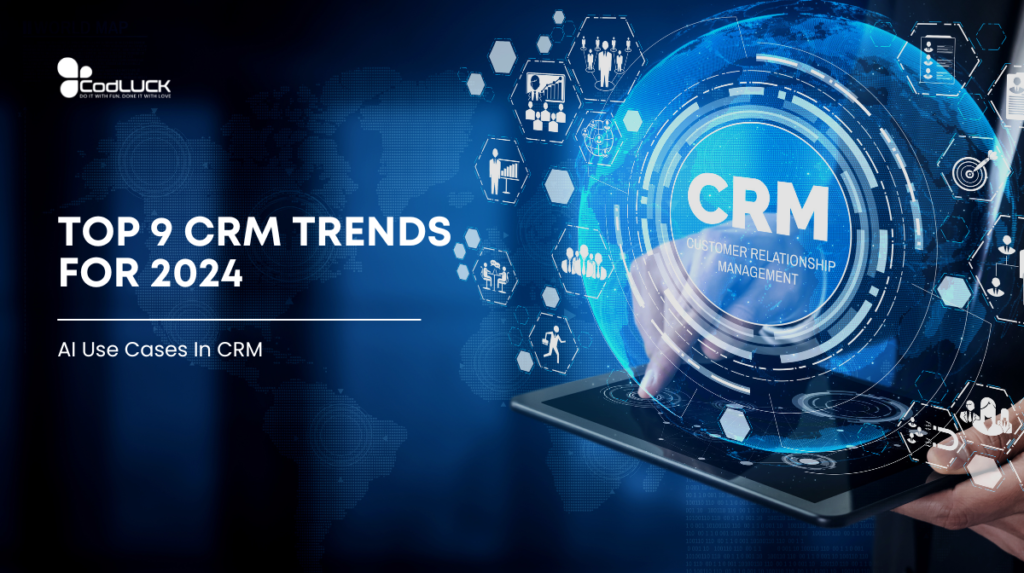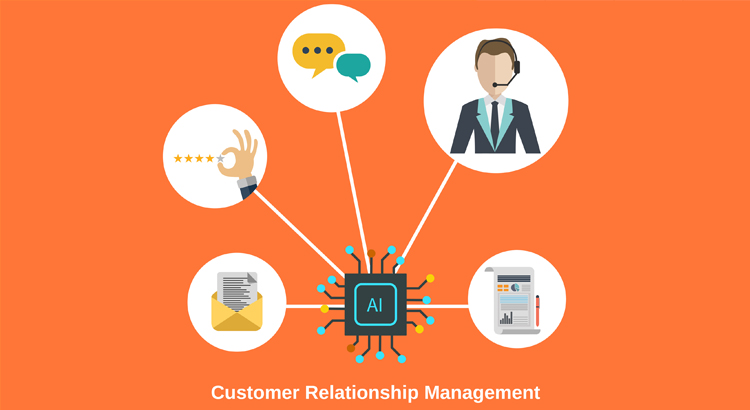As the CRM market continues to boom, businesses must stay abreast of transformative trends that could reshape customer relationships and strategic approaches in 2024. Following the explosive rise of AI technology in 2023, the looming question is: How will it impact CRM this year? This blog post will explore the top 9 CRM trends in 2024 and some use cases of AI in CRM.
Key Take Away – Top 9 CRM Trends For 2024
1. Increasing Hyper-Personalization for Customers
2. Uniting Sales, Marketing, and Operations
3. AI Integration
4. Social CRM
5. CRM Mobile Apps
6. Self-service and Simple CRM
7. Data Security and Privacy Compliance
8. Reliable, Affordable Integrations
9. Customer Experience Is Still The Key
What Is CRM? Main Functions Of CRM Introduction
CRM stands for Customer Relationship Management, which is a comprehensive management approach in which companies offering products and services aim to improve mutual benefits for both customers and companies by creating close, trusting relationships with customers, and by conducting activities to turn customers who have made purchases into repeat customers and repeaters into fans.

1. Customer Information Management Functions
The customer information management function of CRM is more than just recording business card information or storing transaction histories. In addition to this basic information, it records detailed information such as the name of the person in charge or the decision maker, contact information for each person, the number of contacts, the contents of inquiries, and the status and contents of business negotiations.
2. Follow-up Functions
CRM also has the ability to record participation in events and seminars and to send follow-up e-mails through its e-mail distribution function.
3. Customer Analysis Functions
By analyzing the customer information managed by CRM, you can determine who are the “best customers” and what kind of products and services they prefer, and develop your marketing accordingly. By analyzing CRM-managed customer information, it is possible to determine who are the “best customers” and what kind of products and services they prefer, and to develop marketing activities that match their preferences. One method of finding quality customers is called RFM analysis. This method ranks customers by Recency (number of days since last order), Frequency (number of purchases to date), and Monetary (total purchase amount).
In order to build a good relationship with quality customers who have already done business with your company many times and bring profits to your company, it is effective to offer products and services that are not available at other companies or not offered to regular customers, instead of continuing to offer the same products and services.
By understanding the latent psychology of customers based on the information stored in CRM and finding the points where customer loyalty and satisfaction can be increased, it is possible to increase customer lifetime value (Lifetime Value: the total value a customer brings to a company over his/her lifetime) more accurately and more efficiently than in the past. Lifetime Value: The total value that a customer brings to a company throughout his or her lifetime.
4. Customer Support Functions
Finally, customer support is an important function of CRM.
It is generally said that it costs five times as much to sell a product to a new customer as it does to sell a product to an existing customer (the 1:5 rule). Therefore, it is more effective to reduce the probability of an existing customer’s defection than to develop new customers, and a 5% improvement in customer defection will improve the profit margin by 25% (5:25 law).
Since the quality of customer support after the purchase of a product or use of a service has a significant impact on the customer’s decision-making process, it is essential to improve the quality of customer support to prevent the defection of existing customers. By using information such as products purchased by customers, past inquiries, and frequently asked questions from customers who have purchased the same products, it is possible to provide quick and high-quality customer support.

CRM Trend For 2024
1. Increasing Hyper-Personalization for Customers
In today’s highly competitive business environment, personalizing communications is not just a choice—it’s an absolute necessity. At the heart of effective personalization lies robust data, and your CRM is the engine driving this transformative capability. The key to elevating customer experience lies in the depth and breadth of your CRM data. The more comprehensive and detailed your data, the more finely tuned your ability to tailor the customer experience. Delve deep into your CRM insights to craft and deliver customized messages, provide spot-on recommendations, and unveil enticing deals that strike a chord with your diverse customer base.
CRM technology has been one of the earliest tools in sales and marketing. Looking ahead, we firmly believe that companies harnessing the full potential of their CRM data will wield a significant competitive advantage. This time is the most suitable time for exploration and innovation. Don’t miss the opportunity to maximize the potential of your CRM system this year—stay ahead in the dynamic and ever-competitive market landscape.
2. Uniting Sales, Marketing, and Operations
Businesses can achieve key performance indicators (KPI) by aligning sales, marketing, and operations that every aspect of your business works together towards a shared end goal. Each department supports one another and, most importantly, the customer. This unified approach ensures that your CRM platform becomes a powerful tool, revealing how each department contributes to the customer journey at every stage of the sales funnel.
CRM technology has been one of the earliest tools in sales and marketing. Looking ahead, we firmly believe that companies harnessing the full potential of their CRM data will wield a significant competitive advantage. This time is the most suitable time for exploration and innovation. Don’t miss the opportunity to maximize the potential of your CRM system this year—stay ahead in the dynamic and ever-competitive market landscape.
3. Welcome AI As A Transformer

“AI is an ingredient, not an entree,” according to marketing strategist Jay Baer. Just like data, he says, you’ll find AI as a way to help you do your job better, not avoid your job altogether. So what will AI look like in CRM? It will do tasks and make observations and recommendations to the humans who work within it.
Some users can access AI right in your CRM rather than hopping into Jasper or ChatGPT. AI technology allows CRM solutions to collect and analyze vast amounts of data from various sources, enabling businesses to gain deeper insights into customer preferences and behavior patterns. So what will AI look like in CRM? It will do tasks and make observations and recommendations to the humans who work within it.
- Writing – AI in CRM improves email content, helps you develop ideas for your blog and more. AI’s data analysis can help you discover the type of content your audience wants to receive so you can create it in a way that lands.
- Reporting – With natural language processing (NLP), you simply need a command. Send a request to your CRM’s AI ChatBot and have a beautifully filtered report ready for your client or senior team members at the click of a button.
- Emails – AI can predict user behavior and show you who engages with your emails and exactly when. Also, you can target specific send times for specific people — great for any marketing campaign.
- Data Capture – Data capture is automated when AI is integrated with a CRM.
- Data Cleansing – AI will spot duplicate data for you and flag the potential issue so you can merge data at the click of a button.
4. Social CRM

Social CRM is the integration of social media tools such as Twitter, Meta, LinkedIn, etc. with the CRM platform to support customer relationship management. Recently, with each marketing stage, social networks have played a particularly important role and adding Social elements to CRM is required. Social CRM is a company’s strategic approach to understanding and interacting with its customers through all those stages.
Harnessing the power of Social CRM enables organizations to promptly engage with comments, fostering stronger connections with existing and potential customers. Beyond immediate interactions, businesses can integrate valuable user feedback into their future strategies, ensuring alignment with customer expectations. Social CRM is ushering in a revolution, transforming the way businesses connect with their audience and adapt dynamically to their evolving needs.”
5. CRM Mobile Apps
Today’s CRM buyers demand accessibility at their fingertips, emphasizing the indispensability of a mobile app. They won’t look at a CRM without a mobile app. The surge in mobile app usage reflects the evolving needs of customers and employees who seek seamless CRM access on smartphones and tablets. Mobile CRM solutions play a pivotal role in facilitating real-time connections for sales representatives, ensuring they can stay engaged with clients in the field and respond promptly to inquiries and service requests.
The 2024 and beyond trend is to ensure that CRM mobile apps continue to deliver the features and experience that on-the-go users need to be successful. Regular updates and enhancements are not just recommended; they are a fundamental necessity for ensuring sustained success in the dynamic landscape of CRM.
6. Self-service and Simple CRM
In 2023, big tech companies lay off thousands of employees. As a result, new businesses are created more and more. Out of the gate, these startups and small businesses need a CRM, but can’t afford an expensive, legacy system. In response, a prominent trend in CRM for 2024 is the introduction of self-service CRMs. They are designed to be user-friendly, require minimal technical expertise or support, and often fall under the low-code or no-code category.
Operating on cloud-based platforms simplifies setup and enables easy scalability. These simple CRMs excel in user-friendliness, making them ideal for small businesses and solopreneurs, providing cost-effective solutions for streamlined operations and efficient growth in a competitive market.”
7. Data Security and Privacy Compliance
Data security and privacy compliance are significant concerns in CRM. In the face of increasing cyber threats, organizations must ensure comprehensive security measures to protect sensitive information. This goes beyond basic firewalls and antivirus software; businesses need robust security strategies, including employee training and proactive system monitoring. Customers will only choose SaaS vendors who hold these same safeguards.
The CRM trend here is nothing new, but rather a continued focus on ensuring that the most current and effective tactics are in place with the CRM provider you choose.
8. Reliable, Affordable Integrations
In the current CRM landscape, integrating systems with key business applications like marketing automation, e-commerce, and ERP is vital for operational efficiency. Businesses adopting CRM in 2024 anticipate straightforward and cost-effective integrations. Unlike in the past, where legacy CRM providers charged exorbitant consulting fees to create and execute integrations. In case of software updates, integrations would break and those expensive integrators would be called back to fix – which would result in more fees.
Today’s modern CRMs include drag-and-drop integration builders that require low-code or no-code are the rule rather than the exception.
9. Customer Experience Is Still The Key

Customer experience including aspects beyond sales and support, was a key focus. In an era of tightening budgets, the buying committee’s conversation about any SaaS investment will include questions like, “What is the impact on our customers?” and “How will this impact our NPS (Net Promoter Score)?”. While tech doesn’t solve people’s problems, it supports those addressing the issues. The applications that win purchase approval will be the ones that can demonstrate positive CX impact in 2024 and beyond.
As CRM is intricately tied to CX, CRM providers must continually showcase specific features and use cases that position CRM as a strategic investment.
To Sum Up
A CRM is your business’s core. CRM trends and functions are so interesting to look at and discuss, but the real driving force behind effective CRM usage is people within an organization.
Considering a CRM that is fast-released, secure, and easy-to-customize? Don’t hesitate to leave a message and we will support you.


